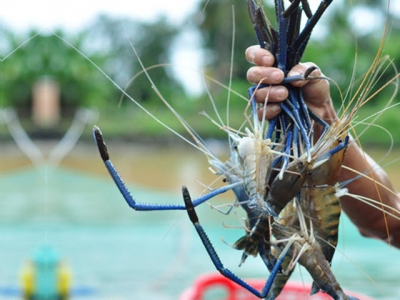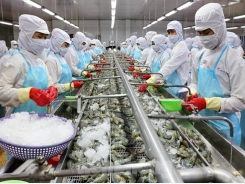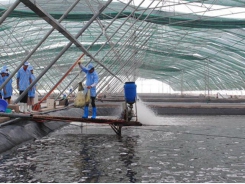The giant tiger shrimp hub on the Đồng Nais laterite soil mountain

Even though Trà Cổ is full of laterite soils, local people are quite successful with cultivation of giant tiger shrimp which has become so famous now.
The laterite soil Trà Cổ commune of Tân Phú district (Đồng Nai) has been considered the capital of giant tiger shrimp. Fresh water is transferred to shrimp ponds from ravines through plastic pipes. Pure and clean water helps shrimps weigh up well and be more delicious than those which are cultivated in other areas.
Trà Cổ has been engaging in giant tiger shrimp farming for twenty years with increasingly accelerated ponds, shared a local farmer. Looking at the vast pond beside the house, he said, “There were a few households. But it grew up to tens of ponds in sizes in 2016, making total farming area as many as over 30 hectares and reaching 54 hectares this time”.
The giant tiger shrimp farmers in Trà Cổ are applying the traditional practices of cultivation, which rarely depends on industrial feed. These delicious shrimps are fed cooked corn mixed with small fishes. The well cooked feed is spread in the pond at low density.
Farmer Đoàn Quốc Năm, who owns over 2,000m² of shrimp ponds said: “Giant tiger shrimp can grow in freshwater and brackish water. The pure and clean water source in Trà Cổ has helped them develop well. Moreover, shrimp in the ponds full of laterite soils grow faster than those in common ponds and can be harvested after three months”.
As shrimp farming has brought in higher income, Trà Cổ’s people have consolidated sunken laterite soil area into growing ponds. According to them, water source from ravines can be affected by drought in the dry season. Thus, shrimp farming lasts from April of lunar Calendar to January next year. Farmers have to take a break in the dry season and consolidate their ponds. Farmer Hoàng Văn Bình said his 0.5-hectare-shrimp pond is waiting for the harvest season at the Tet Holiday run-up. As shrimp grows up fast, he has harvested nearly 1.5 tons to sell customers. According to Bình, one hectare will produce 2-2.5 tons of shrimp on average per year.
In Trà Cổ, giant tiger shrimp is sold to seafood traders or directly to restaurants and hotels in Đồng Nai, Hồ Chí Minh city and Bình Dương. Trade Phạm Trí Tài said that he collected 4-5 tons of giant tiger shrimp to sell traders who were satisfied with the quality of big size shrimp.
“Shrimps size 10-15 pcs/kg are the most favorite ones that are used for steaming or grilling”, shared Tài. He added that the price of shrimp was ranging at 180,000 dong/kg, from which shrimp farmers can benefit up to 300 million dong per hectare.
Today, giant tiger shrimp farmers in Trà Cổ have started to follow VietGAP practice to meet the demand in high quality products. According to Nguyễn Chí Bình, vice chairman of Trà Cổ People’s committee, the commune has now around 54 hectares of giant tiger shrimp with 30 hectares being applied VietGAP practice.
For effective development, the Đồng Nai Fishery Sub-department sent its officers to local areas to hold training courses and provide VietGAP shrimp farmers with technical support. Many households in the commune are actively producing scientifically and in orders, while Trà Cổ are forming a Fishery Cooperative.
According to the Trà Cổ commune People’s Committee, shrimp cultivation can bring in high income but the lack of water in the dry season somehow affects local farmers. Thus, the commune authority has proposed the Đồng Nai provincial Agriculture and Rural Development Department to build a canal to get water from Đồng Hiệp irrigation damp of Phú Điền commune to the growing ponds. This project is under topographic survey and checked for water quality by the Agriculture and Rural Development Department.
Trà Cổ commune is proceeding the plan of advertising its specialty local giant tiger shrimp in local tourism destinations and restaurants.
Có thể bạn quan tâm
Phần mềm

Phối trộn thức ăn chăn nuôi

Pha dung dịch thủy canh

Định mức cho tôm ăn

Phối trộn phân bón NPK

Xác định tỷ lệ tôm sống

Chuyển đổi đơn vị phân bón

Xác định công suất sục khí

Chuyển đổi đơn vị tôm

Tính diện tích nhà kính

Tính thể tích ao hồ



 Mekong Delta aims for sustainable shrimp production at…
Mekong Delta aims for sustainable shrimp production at…  Farming in the Era of Industry 4.0
Farming in the Era of Industry 4.0